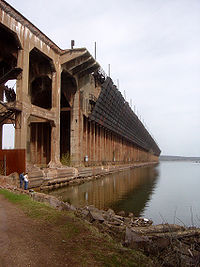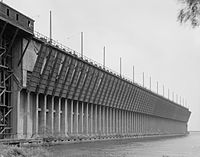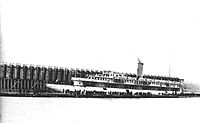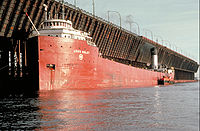- Ore dock
-
 The Wisconsin Central Railway (later Soo Line) ore dock in Ashland, Wisconsin 1,800 ft (550 m) long, b. 1916
The Wisconsin Central Railway (later Soo Line) ore dock in Ashland, Wisconsin 1,800 ft (550 m) long, b. 1916
 Ore dock (b. 1931) in Marquette, Michigan
Ore dock (b. 1931) in Marquette, Michigan
 The IR&HB ore dock at Skanee, Michigan. The steamer Christopher Columbus (362 ft) is in the foreground. ca. 1893
The IR&HB ore dock at Skanee, Michigan. The steamer Christopher Columbus (362 ft) is in the foreground. ca. 1893
An ore dock is a large structure used for loading ore (typically from railway cars or ore jennies) onto ships which then carry the ore to steelworks or to transshipment points. Most known ore docks were constructed near iron mines on the upper Great Lakes and served the lower Great Lakes. Ore docks still in existence are typically about 60 feet (18 m) wide, 80 feet (24 m) high, and vary from 900 feet (270 m) to 2,400 feet (730 m) in length. They are commonly constructed from wood, steel, reinforced concrete, or combinations of these materials.[1]
They are commonly used for loading bulk ore carriers with high mass, low value ore, such as iron ore, in raw or taconite form.
Contents
Construction
The typical construction of an ore dock is a long high structure, with a railway track or tracks along the top with a number of "pockets" into which ore is unloaded from cars, typically by gravity. Each pocket has a chute that can be lowered to discharge the ore into the hold of a ship berthed alongside. The use of pockets and chutes allows loading the dock asynchronously of its discharge into the freighter.[2]
The docks storage bins or pockets typically are wider at the top than the bottom, and lead to movable steel chutes. These chutes project out over the water at a slight angle from the sides of the docks. The hinged chutes, which when lowered allow ore to drop into ships from the pockets, are located at twelve-foot intervals over the length of the dock.
This spacing is not coincidental, as the docks and the lakers they could load evolved together, and laker hatch spacing is typically 12, or 24-foot (7.3 m) on center.
History
Ore docks were a common sight in many Lake Superior ports of Minnesota, Wisconsin and especially Michigan. Rich iron ore deposits were first discovered in the Upper Peninsula in the 1840s and remain a significant source of wealth for the state. By the 1890s, Michigan was the largest supplier of iron ore in the United States. Railroads would haul ore from the mines to great ore docks on the Great Lakes in places such as Escanaba and Marquette, where it would be loaded on ore freighters and transported to the rest of the country.
Iron ore was first discovered in Michigan's Upper Peninsula on September 19, 1844, by William A. Burt, who was then employed to lead a party engaged in surveying the Upper Peninsula on behalf of the United States government. Variations in the readings of magnetic compasses employed suggested that something was disturbing the local magnetic fields, and, on investigation of part of the Marquette Iron Range, ore was found as close to the surface as just below the sod.[3]
Development of this find was ongoing throughout the 1840s and early 1850s. The initial focus was on producing iron locally, as shipping was difficult. Early shipping attempts using mule teams, plank roads, and barrels loaded as deck cargo on schooners required transshipment after portaging the St. Marys River rapids, and costs proved prohibitive. However, as the mines continued to develop and railways were put in place, the volume of ore increased, far outstripping the local production capacity. In 1855, the Soo Locks opened, and the volume of ore shipped increased, with the first year seeing 1447 tons on various brigs and schooners. The first dock specifically for the ore trade was built in Marquette in 1857. It was flat rather than elevated, and the vessels were loaded with wheelbarrows.[3]
By 1860, the volume of ore shipped through the Soo Locks had increased to 114,401 tons, only to fall again to 49,909 tons in 1861 after the American Civil War broke out. However, by 1862, an additional wooden dock had been constructed at Marquette, this time featuring an elevated railway trestle for ore jennies to discharge ore into pockets. Schooners now started to feature regularly spaced hatch covers, speeding up loading.[3] However steamers of the day were not well adapted for bulk cargoes such as iron ore. They did not have hatches through their decks. Instead they had gangways through the sides. So ore shipments were loaded via wheelbarrows through the gangways. The docks had provisions for this by having a flat surface on one side and moorings directly under the pockets for schooners to receive the ore directly, while steamers moored on the opposite side of the dock.[3] However, unloading was still a laborious hand-powered affair.
During this period, the iron ore trade was dwarfed by the grain and lumber trade. For example, grain received at the port of Buffalo, New York, alone in 1866 were about 1,500,000 tons, and the lumber received at Chicago, Illinois, were about 400,000 tons, whereas the received amount of iron ore at all Lake Erie ports amounted to only 278,976 gross tons.[3] Marquette remained the only port on Lake Superior that shipped iron ore until 1876. [4]
After the war, advancement was rapid. The Cleveland Iron Mining Company's dock was 30 feet (9.1 m) above the lake level and was originally built with 29 schooner pockets and 6 steam boat pockets but, by 1872, had been extended an additional 350 feet (110 m), providing 54 additional pockets. During the 1873 season, the total tonnage of iron ore shipped from the port of Marquette was 1,175,000 tons.[4]
As additional ranges (the Gogebic, Menominee East, and Menominee West) began to be developed, with the acceleration of the US as an industrial power, other (primarily Lake Superior) ports also got ore docks. For example, Ashland, Wisconsin, the natural port for the Gogebic Range, had three docks by 1916, the first built by the Milwaukee, Lake Shore and Western Railway in 1884-1885. It was 1,400 feet (430 m) long, with 234 pockets, and four tracks on the dock, and could hold 25,000 tons of ore.[5]
The natural port for the Menominee East range was Escanaba, Michigan; the first docks there were built in 1865.
Today
Many docks have been torn down or abandoned, but the Cleveland-Cliffs dock, one of the docks at Marquette, Michigan, recently loaded its 400 millionth ton of ore after 90 years of service.[6] (The other dock, built later by Merritt-Chapman & Scott for the Duluth, South Shore and Atlantic Railway (DSS&A) was taken out of service in 1971.The largest dock of the type in the world exist in Superior, Wisconsin, as part of BNSF's Allouez Taconite Facility. The docks are still off limits, because the conveyor belt that feeds the present day BNSF dock runs through the facility. [7]) Ore docks are mentioned in popular culture, at least one high school athletic team, the Ashland, Wisconsin Oredockers takes their name from them,[8] and they have been mentioned in song.[9]
See also
- Lake freighter - general bulk cargo ship whose evolution paralleled that of the docks.
- Hulett a device used to remove ore from the freighter's holds at the other end of the journey
References
- ^ Cooleybeck, Patrick — Moshe Safdie & Associates, Somerville, MA. ""Iron ore docks of the Great Lakes"". ABSTRACTS from Paper Sessions of the SIA Annual Conference held on June 3, 2000 in Duluth, MN. http://www.siahq.org/conference/duluth/papersessions/abstracts.html. Retrieved 2008-01-25.
- ^ "Check out Marquette's Iron Ore Docks". Archived from the original on 2007-12-14. http://web.archive.org/web/20071214111324/http://www.marquettecountry.org/ore.php. Retrieved 2008-01-23.
- ^ a b c d e "History of the Iron Ore Trade". 1910 Annual Report of the Lake Carriers' Association. http://web.ulib.csuohio.edu/SpecColl/glihc/articles/carrhist.html. Retrieved 2008-01-25.
- ^ a b "Maritime History". Marquette County Community Information site. http://www.mqtinfo.org/history0006.asp. Retrieved 2008-01-26.
- ^ "Ashland's iron ore docks, a fascinating history". Wisconsin Central. http://www.wisconsincentral.net/Culture041907.html. Retrieved 2008-01-26.
- ^ "Ore dock marks 94-year milestone". http://www.miningjournal.net/page/content.detail/id/49.html?nav=6. Retrieved 2008-01-23.
- ^ "Marquette's Lower Harbor Trestle & Dock History & Removal". http://www.andylphoto.com/trains/trestle/. Retrieved 2008-01-23.
- ^ "Ore dock walks the plank, tower gets new ones". Archived from the original on 2007-12-14. http://web.archive.org/web/20071214055959/http://www.jsonline.com/story/index.aspx?id=673733. Retrieved 2008-01-25.
- ^ "Scene IX". http://www.cesa12.k12.wi.us/30thstar/sceneIX/sceneIX.htm. Retrieved 2008-01-25.
Categories:
Wikimedia Foundation. 2010.

